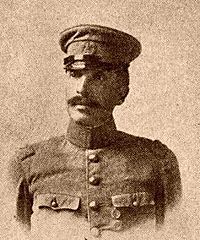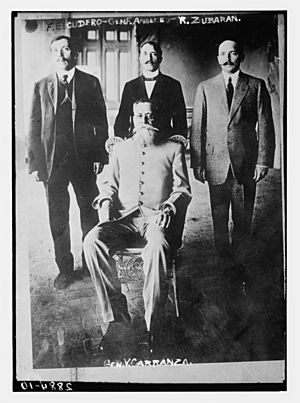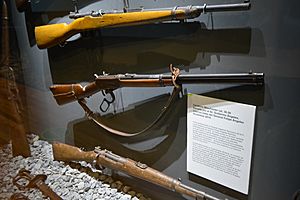Felipe Ángeles facts for kids
Quick facts for kids
Felipe Ángeles
|
|
|---|---|

Felipe Ángeles
|
|
| Born | June 13, 1868 Zacualtipán, Hidalgo, Mexico |
| Died | November 26, 1919 (age 51) Chihuahua City, Chihuahua, Mexico |
| Allegiance | Conventionists (1914-19) Constitutionalists (1913-14) Maderistas (1911-13) Porfiriato (1892-1911) |
| Service/ |
División del Norte (1913-19) Federal Army (1892-1913) |
| Years of service | 1892–1919 |
| Rank | Brigadier General |
| Battles/wars | Mexican Revolution |
Felipe Ángeles Ramírez (1868–1919) was a brave Mexican soldier and an important leader during the Mexican Revolution. He started as a colonel in the Mexican army, known as the Federal Army, during the time of President Porfirio Díaz. Later, he became a general when Francisco I. Madero was president.
After a difficult event called the Ten Tragic Days, Ángeles did something special. He was the only general from the old Federal Army to join the revolutionary fighters in northern Mexico. He worked closely with General Pancho Villa and his famous army, the División del Norte.
Contents
Early Life and Education
Felipe Ángeles was born on June 13, 1868. His birthplace was Zacualtipán, in the state of Hidalgo, Mexico. His parents were Felipe Ángeles and Juana Ramírez. His father was a small farmer. He had fought in the Mexican–American War in 1847. He also fought to remove Emperor Maximilian in 1862.
Felipe Ángeles went to primary school in Molango, Hidalgo. He then studied at the Instituto Literario in Pachuca. In 1883, at just 14 years old, he joined the Military Academy in Mexico City.
Military Career and Studies Abroad
In 1892, Ángeles became a lieutenant of engineers. He focused on making the Federal Army officers better trained. He taught many classes at the military academy. By 1896, he was a captain of artillery. In 1901, he became a major. Three years later, he was promoted to lieutenant colonel. By 1908, he was a full colonel.
That same year, he traveled to France. He went there to study the newest artillery weapons and methods. While teaching, he met Clara Kraus, a teacher from California. They got married in November 1896.
Colonel Ángeles was still in Paris when the Mexican Revolution began in late 1910. His request to return to Mexico was not approved. So, he did not take part in the early part of the revolution led by Francisco Madero. In France, he worked on improving a powerful cannon. In May 1911, the French government gave him a special award, the Knight of the Legion of Honor.
Joining the Revolution
Colonel Ángeles came back to Mexico in January 1912. Soon after, he met the new President Francisco Madero. Madero made Ángeles the director of the Military Academy at Chapultepec. During this time, he spent a lot of time with President Madero. He became known as a smart, honorable, and dignified officer. In June 1912, he was promoted to brigadier general.
President Madero's government faced many challenges. In August 1912, Madero sent General Ángeles to Morelos. His job was to fight against the rebellion led by Emiliano Zapata. Ángeles, with Madero's agreement, changed the harsh military tactics. He offered forgiveness to revolutionaries who stopped fighting. For those who refused, Ángeles used modern warfare, including air attacks. However, he made sure not to harm regular people on purpose. This did not end the rebellion, but it did make the fighting less violent.

In February 1913, a military takeover happened. It was known as La decena trágica (The Ten Tragic Days). A group of conservative soldiers attacked the National Palace. The attack failed, and the plotters hid in an armory. President Madero chose General Victoriano Huerta to lead the loyal troops. Madero then went to Morelos to talk with Ángeles. Madero and Ángeles returned to Mexico City. The plan was for Ángeles to take charge of Madero's forces. But the army staff said Ángeles was not officially a general yet. Congress had not confirmed his promotion.
After ten days of fighting, General Huerta made a deal with the rebels. Huerta, with the help of the U.S. Ambassador, arrested President Madero, Vice-President Pino Suarez, and General Ángeles. Sadly, the president and vice-president were later killed. Ángeles was put on a fake trial. He was accused of killing a child during the fighting. Ángeles defended himself very well. Instead of being executed, Huerta sent him away to France.
Return to Mexico and Joining Villa
While in Paris, General Ángeles met people who were against the new Huerta government. He was convinced to return to Mexico in October 1913. He joined the anti-Huerta forces led by Venustiano Carranza in Sonora. Carranza confirmed Ángeles's rank as brigadier general. He also made him Secretary of War in the new revolutionary government.
However, a powerful group from Sonora did not trust Ángeles. They saw him as part of the old government. To make them happy, Carranza made Ángeles the sub-Secretary of War instead. In this role, Ángeles planned a big attack on Mexico City. It involved three main groups: General Álvaro Obregón from the west, General Pancho Villa from the center, and General Pablo González from the east.
In January 1914, Ángeles went with Carranza to Chihuahua. They met with Pancho Villa. Ángeles was not happy working for Carranza. He convinced Villa to ask Carranza to put him in charge of Villa's artillery. Villa asked for Ángeles's help, and Carranza agreed. So, in March 1914, Ángeles joined Pancho Villa's Division of the North.
Working with Pancho Villa

General Ángeles became one of Villa's most important military and intellectual advisors. He was the Chief of Artillery in 1914. He helped Villa win big battles that year. These included the capture of Torreón, the Battles of San Pedro de las Colonias and Paredón, and the capture of Zacatecas in May 1914.
Before the attack on Zacatecas, Ángeles played a key role. The generals of the Division of the North disobeyed Carranza's order to stop their advance. This "disobedience" helped defeat Huerta's army. But it also caused a big split between Carranza and Villa.
After Huerta's defeat, Ángeles represented Villa at the Convention of Aguascalientes in October 1914. This meeting was supposed to end the fighting. Instead, it led to a complete break between Villa and Carranza. Ángeles stayed with Villa's group when civil war started again in early 1915. Ángeles led his first independent command and captured the city of Monterrey in January 1915.
However, Villa's forces were badly defeated in the spring of 1915 by Carranza's General Obregón. Ángeles had to leave Mexico and live in Texas. There, he tried to make a living as a dairy farmer.
Final Years and Execution
While in Texas, Ángeles joined a group called the Liberal Mexican Alliance. This group wanted to unite exiles to stop the war and form a new government. When World War I ended in November 1918, Mexico was still in civil war. Ángeles believed the United States would invade Mexico if the fighting did not stop.
In December 1918, Ángeles secretly returned to Chihuahua. He joined Pancho Villa again. By this time, Villa no longer had a large army. He was only able to lead small guerrilla attacks. Both the Mexican and American armies were chasing him. Ángeles wanted peace. He was a peacemaker and a socialist who cared about people. But he could not convince Villa to stop fighting.
After Villa's attack on Ciudad Juárez in June 1919 (which Ángeles did not join), Ángeles felt hopeless. He saw no end to the long and bloody civil war. Tired, sick, and very disappointed, he left Villa's camp. He wandered for a while without money or support. He was then betrayed and arrested by the Carranza government.
He faced a military trial in Ciudad Chihuahua. It was a show-trial, meaning the outcome was already decided. Ángeles knew Carranza would never forgive him. He gave a brave and passionate speech defending himself. At 10:45 pm on November 25, 1919, the court sentenced him to death. On November 26, 1919, he was executed in front of the state prison in Chihuahua.
Legacy
Mexican President Andrés Manuel López Obrador announced on April 24, 2019, that a new airport would be built in Mexico City. It would be named Felipe Ángeles. The airport started working in 2022.
Books
- Slattery, Matthew: Felipe Ángeles and the Mexican Revolution, 1982
- Katz, Friedrich: The Life and Times of Pancho Villa, 1998
- Jackson, Byron: "The Political and Military Role of General Felipe Angeles in the Mexican Revolution, 1914-15" (1976, an unpublished dissertation submitted to the faculty of the Graduate School of Georgetown University, 1976)
- Felipe Angeles is a major character in The Friends of Pancho Villa (1996), a novel by James Carlos Blake
See also
 In Spanish: Felipe Ángeles para niños
In Spanish: Felipe Ángeles para niños


